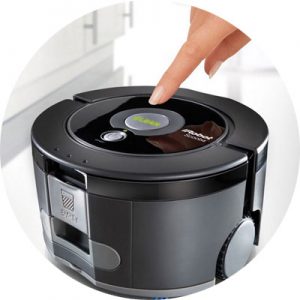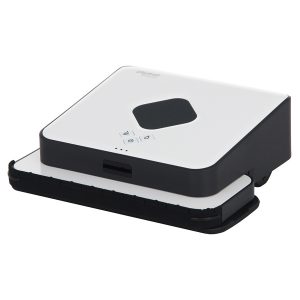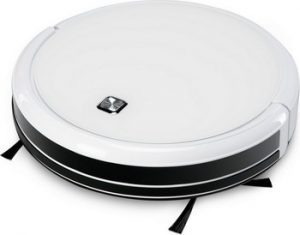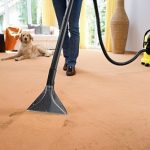 More recently, the housewives, cleaning the apartment or house with a vacuum cleaner, could only dream of a "mythical" robot, ready to perform routine dust removal for them, followed by wet cleaning. Years passed, and now manufacturers of household appliances produce more and more models of robotic vacuum cleaners that independently clean the room. But is the result of independent work of the gadget, which has the title of "best", comparable in quality to cleaning a person? What is the principle of operation of a washing robot vacuum cleaner? What criteria need to be borne in mind when deciding to buy a vacuum cleaner that has advanced automated functions, in particular wet cleaning? We know the answer and are ready to give it to you in this article.
More recently, the housewives, cleaning the apartment or house with a vacuum cleaner, could only dream of a "mythical" robot, ready to perform routine dust removal for them, followed by wet cleaning. Years passed, and now manufacturers of household appliances produce more and more models of robotic vacuum cleaners that independently clean the room. But is the result of independent work of the gadget, which has the title of "best", comparable in quality to cleaning a person? What is the principle of operation of a washing robot vacuum cleaner? What criteria need to be borne in mind when deciding to buy a vacuum cleaner that has advanced automated functions, in particular wet cleaning? We know the answer and are ready to give it to you in this article.
Content
What it is
Vacuum cleaner robot is a gadget for cleaning floors from dust, dirt and small debris, capable, thanks to its technology, to carry out cleaning without involving the user himself in the process. Its classic appearance implies a round or rectangular plastic case with various cleaning brushes - nozzles at the bottom and function buttons on the top surface of the structure. Due to the autonomy of the process, the device in question is traditionally equipped with a special navigation system responsible for “orienting” the robot in the area for the intended cleaning. Traffic vacuum cleaner can be regulated:
- a laser;
- camera
- external or internal sensors.
Currently, most often on store shelves you can find robots with an integrated laser navigation system. It is obvious that the rangefinder laser, prudently included in the design of the device by the manufacturer, allows the vacuum cleaner to identify the fact of the presence of objects near it, and often even an approximate distance to them. These indicators form a kind of room map in the robot’s memory, relying on which, while cleaning it further, it will avoid “towing”, as a result of a “meeting” with a foreign object in its path.
The camera, usually mounted on the upper part of the vacuum cleaner body, makes appropriate measurements to obstacles or vice versa places requiring thorough cleaning. Having determined their location, she gives special “signals” about the need to move in a specific direction. The trajectory of the robot in this case will depend on the algorithm provided by the manufacturer: the device can wash the floor, "sliding" in straight lines or in chaotic directions, determined by the camera readings.
In the case when the fundamental element of navigation is external or internal sensors, the “smart device” independently decides to change direction, “detour” obstacles, and so on. Such adjustment of the vacuum cleaner's movements depends on sharply arising changes in the environment surrounding the robot (a child came running, a dog jumped off the couch, a woman sitting on a chair, stretched out her legs, etc.).
In addition to identifying obstacles in the way, special external sensors allow the gadget of the type in question to find areas of the highest concentration of dirt and clean them for a longer time, while using the maximum amount of their resources.
Having understood how exactly the modern "assistant" will navigate in your apartment or house, you can proceed to the study of an equally important question about the principle of its action.
Cleaning the premises with a robotic mechanism involves sweeping the area with side brushes by moving the collected dirt, dust, hair and so on to the central (main) brush located in the middle of the lower part of the body. The main brush sweeps the particles into the dust box provided by the manufacturer. In this capacity, the next stage, under the influence of compressed air, is the “pressing” of accumulated garbage. Further, having been cleaned by the filters of the dust collector, the air flow goes beyond the limits of the construction of the robot. This fact necessitates the search for a high-quality cleaning element among the constituent vacuum cleaners that can be called the best.
After cleaning the floor of the main amount of debris, dirt and dust, the robot vacuum cleaner begins to "spray" liquid from a special built-in tank. Having distributed the water evenly over the floor, the gadget proceeds to “polish it”, rubbing the floor “to a mirror shine”. The final stage of cleaning, carried out by a washing robot-vacuum cleaner, will be the wiping of dirty water with a special nozzle with its subsequent suction in the tank allocated for this purpose.
Given the battery type of operation of vacuum cleaners of this type, it is important to note the ability of the gadget to independently determine the need for "recharging" and find its own "base". This is made possible thanks to the presence of a special indicator illustrating the low battery charge, and a special IR signal supplied by the charging station of the robot. In the case of supplying the device with a laser or a camera, the vacuum cleaner determines the location and the pattern of movement to it, “from memory”.
Based on the methods of cleaning a given area of the room, robotic vacuum cleaners are usually classified into devices for:
- dry cleaning;
- wet cleaning (plotters);
- mixed cleansing.
If the wet cleaning process was described in the article above, and the principle of dry cleaning is identical with it until the water was "sprayed" on the floor, then the question of what a mixed-type robot vacuum cleaner is is still open. In this case, the suggestion suggests that this type of device for "processing" combines the functions of both wet and dry cleaning. And it is undoubtedly true. The principle of operation of the apparatus with the described properties involves washing smooth surfaces with a special rag nozzle, and carpet coverings with the main and side brushes or an additional turbo brush. This type of vacuum cleaner completely "takes care" of cleaning your home, independently determining which nozzle to use in a particular case.
When determining the need to purchase a washing robot vacuum cleaner in a specific case, it is important for the buyer to have an idea of the main features of its design and functionality:
- The presence of a large number of built-in brushes - nozzles that can provide a thorough cleaning of the room with their action. Using the usual “tools” to remove dust, you will have to spend twice as much time cleaning the flooring first with a vacuum cleaner and then with a rag.
- The presence of a built-in reservoir for detergent or water, "sprayed" by the robot during wet cleaning, can also be attributed to the peculiarities of its structure. It is important to note that the vacuum cleaner does not create puddles, but uses the minimum amount of liquid to disinfect the floor and further polish it.
- A large number of sensors provided by the manufacturer to create the resistance of the device to external damage. Among the most common “functional pointers” are collision sensors, IR touch sensors, drop sensors, dirt sensors and so on. The more additional sensors are built into the body of the robot vacuum cleaner, the safer it will be to use it in a terrain limited by foreign objects.
Summing up the information given in the article, it is advisable to formulate the key advantages and disadvantages of using modern robotic vacuum cleaners that are most common for users.
Positive aspects associated with the result of the activity of the type of device under consideration include:
- ease of use by people with disabilities, due to the automated process and control of the gadget with a remote control;
- practicality for people who often travel or spend a long time at work, outside the home. The robot, according to the schedule set by the user, will carry out dry and wet cleaning of the room independently, activating at the beginning and returning to the “base” at the end of its activity, without additional outside interference;
- high-quality elimination of potential allergens, in particular, wool of furry pets, requiring mandatory daily cleaning;
- lower noise level in comparison with the sound of conventional wired analogs that occurs during direct operation of the robot.
In addition to the undeniably significant advantages of using robotic technology, it is important, when making the final decision on its acquisition, to adequately assess the existing disadvantages as well:
- the inability to carry out wet cleaning, comparable in quality to the “manual method”, due to ill-conceived forms of the body and designs of brushes - nozzles;
- high cost for which you can buy a powerful luxury wired vacuum cleaner;
- ignoring inaccessible places, in particular, areas under furniture, where most often “deposits” of dirt and dust accumulate;
- Considering the combined method of operation of some devices, there is a greater likelihood of the emergence and growth of harmful fungi, microorganisms, mold in the design of the robot, due to the combination of dust collection and storage of liquid in the storage tank.
How to choose
So, having understood the key points of the functional, as well as the advantages and disadvantages of the robot vacuum cleaner, you make the decision to purchase it. Where to start? What indicators should I pay special attention to?
- The cleaning area indicated by the manufacturer in the technical passport of the device should correspond to the size of the room in which the robot is planned to be used. The technical parameter can be more, but not less. Otherwise, the selected model simply “sits down” without “overpowering” the cleaning of all the space provided to it.
- The most optimal way to orient the vacuum cleaner in space is through external or internal sensors. They are able to "adapt" to changing conditions, providing the device with the opportunity to maximize the cleaning of a given area of the room, bypassing obstacles of a different nature and avoiding falls and emergency upheavals.
- It is worth paying attention to the capacity of the dust bag available in the robot. This parameter depends on the initial size of the apartment or house and the user's ability to regularly clean the dust-filled container. A volume of 0.3 to 0.6 liters is considered an average.
- In choosing a vacuum cleaner, its equipment is also important. In an ideal situation, it should include as many replaceable brush heads as possible from the manufacturer, a remote control, a limiter - a “virtual wall”, cameras coordinating movements (depending on the model of the robot).
- An ideal automated vacuum cleaner will have a “scheduled cleaning” mode that allows you to set the user-defined frequency of wet and dry “processing” of the room, based on which the robotic device will autonomously begin to function.
- Speaking about the type of filtration, it is advisable to give preference to a vacuum cleaner that includes HEPA filters in the design. This type of cleaning element is considered to be the most high-quality method of disinfecting the premises, allowing the use of such vacuum cleaners for allergy sufferers.
Analyzing the assortment of automated goods offered by modern manufacturers, it is worth considering, first of all, for compliance with requirements proven brands and their top models, and not try to save money by choosing an unpopular device.
The best models
iRobot Braava 390T

- Types of cleaning: wet
- Type of cleaning available: local
- Battery capacity: 2000 mAh
- Battery life: up to 240 min
- Charging time: 120 min
- Dust collector type: aquafilter
- Area for cleaning: 93 m2
- Weight: 1.8 kg
- Built-in options: building a map of the room with the NorthStar navigation system, dust is not absorbed, but is collected on a dry or damp cloth; Pro-Clean panel with detergent dispenser for continuous wetting
- low noise generated during cleaning
- floor cleaning speed
- lack of the “scheduled cleaning” option
- poor overcoming obstacles
- low-quality floor cleaning
PANDA X900 Wet Clean

- Types of cleaning: dry, wet
- Type of cleaning available: local
- Battery capacity: 2000 mAh
- Battery life: up to 120 min
- Charging time: 300 min
- Dust collector type: cyclone filter
- Area for cleaning: 70 m2
- Suction power: 65w
- Noise Level: 50dB
- Weight: 3 kg
- Built-in options: “virtual wall”, additional brush nozzles, display, fine filter
- appearance
- convenience of cleaning the dust bag
- compactness
- poor overcoming obstacles
- chaotic cleaning scheme
- low quality of individual fasteners
iBoto Aqua V710

- Types of cleaning: dry, wet
- Battery capacity: 2600 mAh
- Battery life: up to 150 min
- Charging time: 120 min
- Dust collector type: cyclone filter
- Area for cleaning: 70 m2
- Suction power: 65w
- Noise Level: 45 dB
- Weight: 3 kg
- Built-in options: liquid collection function, “virtual wall”, advanced equipment, the presence of a fine filter, container containers for water and dust collection
- low noise generated during cleaning
- overcomes obstacles well
- speed of the cleaning process
- quality of cleaning
- periodic loss of contact with the "base"
- easily soiled
Clever & Clean AQUA-Series 01

- Types of cleaning: dry, wet
- Battery capacity: 2200 mAh
- Battery life: up to 90 min
- Charging time: 240 min
- Dust collector type: cyclone filter
- Maximum power consumption: 70 W
- Suction power: 24w
- Noise Level: 54 dB
- Weight: 3.4 kg
- Built-in options: liquid collection function, 6 possible floor cleaning modes, optical sensors, fine filter, “scheduled cleaning”, disinfection lamp
- high-quality dry cleaning
- acceptable noise level
- periodic cleaning option
- poor wet cleaning
- lack of battery charge for 1 cleaning cycle
- chaotic floor cleaning pattern
Everybot rs500

- Types of cleaning: dry, wet
- Battery capacity: 2150 mAh
- Battery life: up to 50 min
- Charging time: 150 min
- Dust collector type: aquafilter
- Suction power: 27w
- Noise Level: 50dB
- Weight: 1.9 kg
- Built-in options: 5 possible modes of floor washing, optical sensors, two rotating microfiber nozzles, rotation speed 130 rpm; the ability to work in manual mode (suitable for cleaning vertical surfaces); automatic wetting of discs from two 60 ml water tanks each
- ease of operation
- build quality
- comfortable nozzles
- acceptable noise level
- insufficient number of sensors
- chaotic cleaning scheme
- "Smearing" the collected dirt on the floor
- short battery life
A robot vacuum cleaner, like any other household “assistant,” must be selected very carefully. Using the information given in this article, namely the advantages and disadvantages of its use, you can easily determine the degree of need to purchase an automated “cleaner” in a particular case, as well as choose the most optimal model for yourself.



